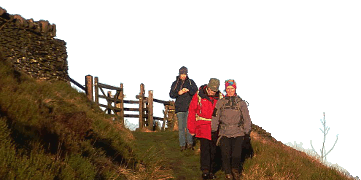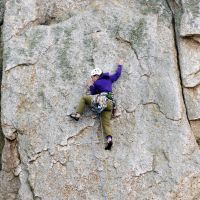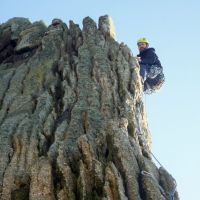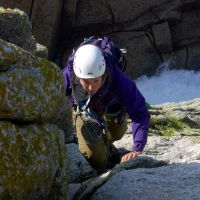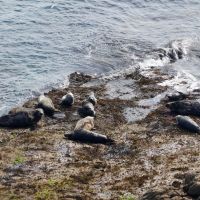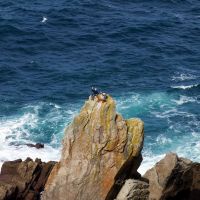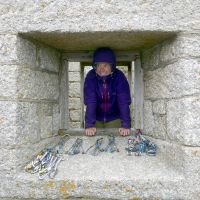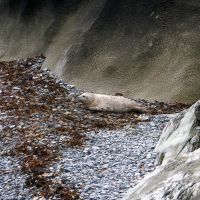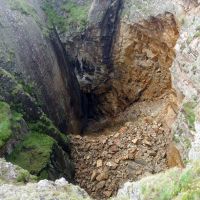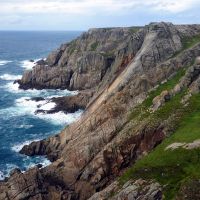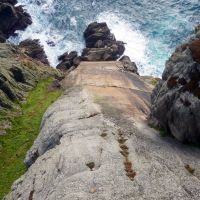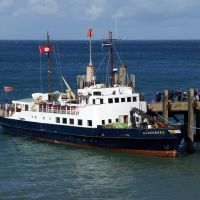Sat 2nd Sep - Sat 9th Sep, 2017
Lundy Climbing
Members attending: Fiona Dixon, John Evans, James Hall (joint meet leader), Gergana Mihalkova (Geri), Dave Wylie, Gareth Williams (joint meet leader).
Lying in the turquoise waters of the Bristol Channel is the magical island of Lundy. Measuring less than 2 miles square this lump of granite rises steeply from the sea providing a high concentration of climbing excellence on its largely immaculate cliffs. As one might expect, Lundy's small size, coupled with its popularity with climbers, means one has to book a long time in advance to arrange a stay on Lundy. It's over a year since we booked to stay on the campsite for this meet.
SATURDAY 2ND SEPTEMBER
The MS Oldenburg sailed from Ilfracombe at 10am; working back from this meant a very early start! Dave left his house at 1:30am to collect Geri, then James, and rendezvous at my house in Timperley in good time for a 3am departure. Several hours of driving and a couple of coffee-stops later we met John and Fiona, and were unloading our gear on the quayside, wondering how strictly the 20kg luggage limit would be enforced. The answer was not at all. No scales in sight, everything was piled into a cargo net, then lowered onto the ship by crane.
Oldenburg was carrying over 200 passengers, the climbers obvious by their enormous rucksacks taken on board as hand luggage. The reason for this is that hold luggage has to be unloaded by the crew, and is then delivered by tractor and trailer to the appropriate accommodation on the island. This process takes hours, so if you want to climb on arrival day, you need to take your gear as hand luggage.
The crossing was calm, and we arrived on Lundy in bright sunshine. A half-mile, steep uphill walk brought us to the Marisco Tavern, and Lundy's reception, where two notices stood out above everything else. First, the island was suffering a severe water shortage, what water there was, was unsafe to drink, and everyone would be given one complimentary bottle of water to last the week! Second, the threat of norovirus meant that regular use of hand sanitiser was strongly recommended. Liberal applications of this persisted throughout the week, regardless of whether or not there was any real risk of norovirus.
With weather so good, everyone was keen to make the most of it. Geri had a sore knee and wasn't planning to climb at all on the trip, so she went for a walk to explore the island. Dave, Fiona and John went off towards Bomber Buttress to make an ascent of Biggles (VDiff, 35m). Standout phrases from the guidebook description are 'a slight climb' and 'vegetated finish'. The route did not disappoint, with Fiona commenting 'it's one of the worst climbs I've ever been on'. The team split the route into two pitches: John led pitch 1, describing it as crumbly and rambling; Dave focussed hard leading pitch 2 which was 'just a scramble, but up vertical choss'. Not the best climbing Lundy has to offer, but the team did well to stay safe and finish without incident on such poor rock.
Meanwhile, James was keen to look at St Patrick's Buttress, but with nine rucksacks at the top of the ab, we decided to look for somewhere a bit quieter. First Buttress South in Landing Craft Bay was deserted and James was keen to lead The Indy 500 (E1 5b ***, 41m). The route was top quality, well worth its three stars. Sustained climbing with plentiful protection and enough rests to make it feel pleasantly strenuous but never desperate.
Upon return to the campsite, our luggage had been delivered, so we got the tents up. As the afternoon turned to early evening, lots of other tents sprang up, all of them small, robust-looking models that should stand up to wind well. All, that is, except one. The 4-person family tent with full standing height that James and I were sleeping in dwarfed everyone else, and meant the KMC team had a spacious base for cooking and socialising.
We headed to the Marisco Tavern. It has a wonderful system of letting one set up a tab that lasts the full week, which makes for very casual spending on beer! One good feed and several pints later we went back to the tents and bed. It had been a very long day with the early start, travelling, climbing and time in the pub. We all needed a good sleep.
SUNDAY 3RD SEPTEMBER
The Force 8 storm hit in the early hours. High winds and heavy rain. Those small-but-rugged tents that the majority were sleeping in seemed to weather the storm well, but the family tent was taking a battering. It wasn't long before James and I were out in the rain, replacing pegs that had been ripped out of the ground. The porch has a sewn-in groundsheet, which was filling up with water fast. Mugs were used to bale this out, and it became clear that even with the pegs hammered in, the poles couldn't take the full force of the wind at the front of the tent. James and I spent several hours stood here, backs against the fabric, pushing back against the wind. We were pretty good as human tent poles, and without our efforts I'm sure the tent would have been totally trashed. Even with our efforts, when the wind died down to normal levels by mid-morning, there was a rip in the fabric, and one of the poles had split. We made repairs as best we could (isn't gaffa tape great!), somewhat dubious they'd last the full week, but it was the best we could do.
It remained misty until mid-afternoon. Various people went out for short walks at different points of the day, but there was much snoozing and no climbing. The day was almost a write off, except for Geri, who had seen seals for the first time. I can't describe her excitement at seeing seals, so I asked her to express it: "Being on this beautiful and wild on most places island was an unforgettable experience for me! Seeing the seals from such a close distance was truly special to me...like touching to a beautiful mysterious underwater world I know so little about but feel attracted by its mighty call".
MONDAY 4TH SEPTEMBER
We woke after a night of much better sleep. The weather was far from ideal -- it wasn't too windy or wet, but low cloud kept on coming and going, provoking a question which tickled Dave's sense of humour: when the fog disappears, is it missed? Whilst the climbing conditions were far from ideal, we were keen to get out and do something. The stunning photo in the guidebook of Seal Slab, coupled with easy routes to do there, made this an obvious target, so the five climbers set off.
John and Fiona's pride and joy was a 100m static rope, bought specially for abseils on Lundy, and we carted this over to Seal Slab. I went down first, deciding that it would be wise to stop above the sea-level ledge as the tide was coming in. Fortunately there was a large ledge well above, spacious enough for 5. By the time we were all down, the waves were lapping over the lower ledge.
The slab could be climbed more-or-less anywhere at about Diff-VDiff standard. Fiona led John and Dave whilst James led me up to the top in one long pitch. The route received mixed reviews, with Fiona commenting 'where was the climbing' when she topped out. In search of something more entertaining, we headed over to the Devil's Slide.
When we arrived, plenty of other teams were there, but desperate to climb, sharing the slab with so many others didn't seem too off-putting. We nipped down another team's ab rope, and by the time the five of us were on the rock, I counted 14 people on this particular rock feature.
Dave was super-keen to climb Albion (VS 4c *** 107m) and James didn't need much persuading to join him on it. Dave describes it as follows. "I went on this meet with just one route on my tick-list: "Albion", the VS up the left hand side of the Devil's Slide. I'd done the eponymous Hard Severe on the RHS twice, once on each of my two previous visits to Lundy (in 1992 and 1997!) and the slightly harder route looked excellent. I led the first two pitches, running them together into one. The technical slab climbing was delightful, with just enough gear to keep my head under control. I then sent James up the rather wet corner higher up the slab. He described his lead as "harrowing" and said that he was suffering from seepage(!). I followed, having to make some weird moves to avoid the dampest of the hand and foot holds. It was much harder than expected (James reckoned at least HVS in the conditions), but it was still the best route of the week for me."
Meanwhile, Fiona, John and myself climbed The Devil's Slide (HS 4a *** 117m). The guidebook gives 5 pitches, but we managed it in 3, leading one each. This is the most famous route on all of Lundy, and there's regularly threads on the UKC forums with people asking if it can be done in a day-trip to the island. Definitely one to tick, but I'm not sure it 100% lives up to the hype.
When we returned to the campsite, we learned from Geri that she had heard rumours that Brazen Ward was the best place on the island for seal-spotting, and that was where she had spent most of the day.
TUESDAY 5TH SEPTEMBER
Another windy night with heavy rain. The repairs to the tent had more-or-less held, though some additional gaffa-taping was needed, and there was a fair amount of bailing out of water with a mug to be done. By mid-morning, it had dried up and was bright and breezy. Time to get out climbing.
James and I headed off to Arch Zawn. The guidebook mentioned a 45m abseil, and we had no intention of lugging the 100m monster over for such a short ab. Fortunately we'd borrowed a 60m ab rope from a club member who will remain nameless. 45m down the cliff we arrived on the ledge with a metre of rope spare. A 60m rope indeed! Still, we were where we wanted to be, that is, on small ledge with heavy seas crashing just a little way below, looking up at the easiest route out, which was a dripping wet Headline (E1 5b *** 42m).
James set off up the first pitch. This started with climbing down a couple of feet into the wet zone, moving sideways and then up onto a higher ledge. Careful timing between waves and he was on the ledge. Ten or so metres higher he was confronted with a very wet and slippery crux. Happily, it was well-protected. After a couple of sizeable falls, a point of aid was the order of the day and he was back onto dry rock. The ab rope crossed the line of the route, and afforded a runner via a prussic loop before the belay was reached. The tide had come in a little, and I carefully repeated the manoeuvre onto the higher ledge between waves. I still don't understand how, but once on this higher perch, a wave broke and submerged me to above the waist -- this in spite of having been stood, in the dry, on a lower ledge, for over an hour! Following the route, I made use of the point of aid too, and was soon leading through on the second pitch, which was both easier and drier than the first. A great adventure. We considered moving on to St Patrick's Buttress, but knew our ab rope was too short for the approach. Double Diamond was also mooted, but by now the tide was in and the seas too rough.
John, Fiona and Dave had spent the day at Beaufort Buttress. Dave led Force 8 (S * 32m), running its two pitches together. Fiona led Hurricane (HS 4a 4a * 31m), describing it as "very soft" for the grade. John led Capstan's Arete (VS 4b * 31m), calling it "even softer". By now, the tide was in and high seas stopped play.
Geri had spent the day seal-spotting again, this time focussing on the jetty area. A new-born pup (thought by the warden to be 4 days old) was being protected by its mother, but made for exciting viewing. Geri attended a lecture "Life above and below the waves" in the Marisco Tavern, and cooked a fantastic vegetable curry, which was more than enjoyed by all.
WEDNESDAY 6TH SEPTEMBER
A day of decent weather at last! Geri wanted to see the seals again; Dave decided it was time for a day off climbing so went with Geri for the morning. Dave spent the afternoon exploring and taking photos, whilst Geri took part in a snorkelling expedition. All gear including wetsuits was provided, and Geri reported enjoying her first experience of snorkelling -- despite the sea being rather rough.
Fiona and John went off for an adventure on Needle Rock. As the name suggests, this is a detached pinnacle, but given the location, a sea stack might be a more appropriate description. A long abseil (thank goodness for that 100m static!) led to the tide-dependent boulder hop out to the Needle. Fiona opened the climbing with a lead of Integrity (HS 4b *** 24m). Descent was by abseil, and the pair judged, correctly, that they had time for another route before the tide would cut off access. John led The Obverse Route (S * 23m). Another abseil and they were down and back across the boulders with plenty of time to spare.
Meanwhile, James and I had been considering a route in Deep Zawn. The zawn itself took a bit of finding, and given the wet first pitch of Headline yesterday, we were keen to get a view of the route before committing to the abseil. But the zawn is well-named. Its depth meant that we couldn't see all the way to the bottom no matter what angle we looked from. We also felt a bit concerned that the shorter ab rope wouldn't be long enough to get us to the base of the zawn, so we walked over to the Egyptian Slabs area, wondering about climbing Immaculate Slab (HVS 5a *** 34m). But there were plenty of rucksacks at the top, with more teams arriving, so we decided against it, and headed back to Deep Zawn. Another pair were in the process of setting up an ab. They didn't want the route we were after, and offered us use of their ab rope, so the attempt was on.
I gave James a fright, tripping at the top of the ab station, but it wasn't long before we were at the bottom of Deep Zawn. A beached seal on the rocks at the back of the zawn watched us as it waited for the tide to come in. The depth of the zawn meant there were no photo-topos of the routes, so it took a while to find what we thought was the start of Quatermass (E2 5c *** 60m). The rock wasn't exactly wet, but it was certainly greasy for around the first thirty feet, where the climbing felt decidedly delicate. The guidebook mentioned good protection, but this didn't seem evident close to the harder moves, so a steady head was needed. Even so, when I did eventually get a good nut in above the crux of the first pitch, the temptation for a quick pull on it was too strong to resist.
James made a great job of pitch 2, which was a sandbag of a pitch up two parallel diagonal cracks, requiring a combination of techniques. The final pitch was mine, following a thin crack (good job we took the RPs). It was a bit contrived, with easier ground to each side, and I think I did step right onto it a bit early. The top-out was through alarming, blocky ground with one perched block in particular causing both leader and belayer concern. Thankfully it stayed put, and James followed a slightly purer line to join me on the top.
Everyone seemed to have enjoyed the day of good weather, and we celebrated with tea in the Marisco Tavern.
THURSDAY 7TH SEPTEMBER
The day started off with good weather, but would it last?
All of us, except Geri, headed over to Battery Point. The guidebook mentioned a scramble descent. The scramble didn't look very inviting, so we set up an ab. Once again the shorter rope proved too short, running out one bad step above where we wanted to be. A bit of jiggery-pokery with some slings and down-climbing, and we were all at the bottom.
John and Dave climbed Horeseman's Route (HS 4a * 42m), swinging leads, with John describing the route as "excellent". Fiona, James and myself went off to look at Double Diamond (HVS 5b *** 35m). Fiona was initially unsure which of the two route on offer she wanted, but as per the guidebook description, was "seduced" by Double Diamond. The route was a bit damp and greasy low down, but the upper slab was brilliant. The long line meant for some inventive rope management, with the final wire being extended via a prussic loop and hex, the quickdraws and slings having run out some moves earlier.
Dave, John and Fiona then headed off to Pilot's Quay, with a view to climbing Quay West (HS 4a * 20m). But the descent was off-putting, and the weather didn't last. As the rain came in, they decided it was time to retreat for hot chocolate.
James and I headed over to St Patrick's buttress for the third time, this time with the 100m ab rope with us. But we found an ab already in place, so were able to nip down that without uncoiling the monster. James was keen for Meninirons (E1 5b ** 56m), and we found a way to scramble past the easy first pitch, leaving 40m of 5b climbing ahead. James was about 15m up this when the rain hit. Not a route for wet conditions, we backed off and looked for the easiest route back to the top, which was Shamrock (VS 4c *** 50m). This went OK in the wet, the only disappointment being the non-event that was pitch 2.
Geri had spent the day on an informative guided walk with a very passionate warden. Plenty of wildlife, and the walk covered the southern part of the island, including the jetty, castle and lighthouse. The curry she made earlier in the week had proved so popular that Geri was persuaded to make it again, and we enjoyed it this time around as much as the first.
FRIDAY 8TH SEPTEMBER
The forecast was poor, and most people decided to wait and see what happened. James, John, Dave and Geri walked down the hill to see the baby seal. After that, Dave walked a complete circuit around the island. Joh, Geri and James headed to Brazen Ward for more seal-spotting, then back to camp. John and James considered Clea (HS 4a * 21m) on Kistvaen Buttress, but (in Fiona's words) 2 drops of rain fell and they bailed, spending the rest of the day sitting in sunshine at camp.
Meanwhile, Fiona took me over to Beaufort Buttress, knowing the best approach from her visit earlier in the week. I led Stuka (VS 4b ** 32m) in one pitch, and we then went around the corner into Freak Zawn. The guidebook is a little lacking here, with the odd factual error and descriptions not really matching the terrain. Fiona started up our best guess as to Salty Dog (VDiff * 40m) but, with hindsight, I think it was actually Dog Watch (VS 4b 22m). No sooner had she gained a bit of height than a squall came in and the route was drenched. Fiona's steady head brought her to a stance with no troubles. From here, we could spot where Salty Dog went, so rigged an ab down to it -- I have no idea how one would get to it without an ab, despite the ledge system the guidebook mentions. The route itself turned out to be something of nothing, but at least we found it!
Our last night on Lundy, tonight was officially party night, which meant pudding after tea in the Marisco Tavern -- and sampling of Highland Park Viking Honour.
SATURDAY 9TH SEPTEMBER
Today was John's birthday -- everyone forgot, and John had to remind us all of the significance of the day. He didn't seem too offended, and to be fair, none of us had reason to know it was his birthday -- except Fiona, but even she was forgiven.
We packed up camp, leaving the tents and luggage to be collected by tractor/trailer and loaded onto the Oldenburg. The ship didn't sail until 5pm, so there was plenty of time to do something, but once again, the weather wasn't playing nicely. John went for a walk and got blown over. James and I went to look at Ulysses Factor (HVS 5a * 103m) but even the approach looked awful in the wet, windy conditions. We opted against the potential for an epic on one of the island's longest routes on the day we had to be back in time for the sailing, so returned to the Marisco Tavern where we whiled away the hours waiting for the departure of the Oldenburg, with several members of the team tackling a puffin-themed jigsaw.
The return sailing back to the mainland was rougher than the outward crossing, but we all survived without and sea-sickness disasters. Oldenburg took us back to Bideford, from where a coach transfer was laid on back to Ilfracombe, from where the long drive back to Manchester began.
REFLECTION
Thanks to all who came and made the meet what it was. We had a week of very mixed weather, which put a bit of a restriction on the climbing we could do. But overall we got a reasonable amount done, and Dave summed up his feelings of the meet as follows: "There were many highlights for me on the trip, but my outstanding memory is of enjoying superb company in a special place. To me, that is what makes the KMC such a great club - it's not just all about the actual climbing."
We chatted about the potential for a return trip to Lundy, likely in 2019 (as it's probably too late to book for 2018 now). We decided we'd definitely not camp, as doing so in poor weather took a lot of energy and effort, leaving less of the same to put to the climbing. We were also unsure of the best way to organise such a trip as a club meet, given that this time around we didn't fill all the spaces we booked and hence lost some money from the club's account. Would members find a 4-day trip to Lundy less of a commitment, and hence more attractive? If you are interested in Lundy 2019, or have a view about that potential meet, please have a word with one of us that attended this meet -- or why not consider organising Lundy 2019 yourself?
Gareth Williams
Meet Promo:
Update 27/7/17: there is a small number of places on this meet now available to non-members with a suitable level of experience. If you are interested, please get in touch.
Lundy
Lying in the turquoise waters of the Bristol channel is the magical island of Lundy. Measuring less than 2 miles square this lump of granite rises steeply from the sea providing a high concentration of climbing excellence on its largely immaculate cliffs. While undoubtedly the major attraction is the Devils Slide, a monstrous slab offering a number of options for those who can put faith in friction, there are hundreds of routes to go at across all the grades with something to suit every sea cliff-loving climber, and if you're a wildlife lover do not despair, while the puffins might have gone home for the year you can expect to have plenty of interaction with the local seal population.
The club has reserved and paid for ten spaces at the campsite on Lundy for the week 2-9 September. As we have paid the money up-front a long
way in advance, we are guaranteed the 2016 price of £42 per person for the week, this is whether or not there are any prices increases for 2017. Members can secure their place on the meet by paying this £42 campsite fee to the club (contact the meet leaders for information on
how to do this). As the campsite booking is now fixed, members wishing to take advantage of this meet will have to pay for a full week's stay (just paying for a few nights isn't an option, unless you can find another member to 'share' a week with you!).
The ferry crossing at present costs £64 return per person (prices might increase by 2017) and we must make our ferry booking at the absolute
latest 2 weeks before the meet. We suggest that for now you book your place on the meet by paying your campsite fees, and closer to the time
the meet leaders will get in touch to coordinate a single ferry booking for members attending the meet.
Places are limited and will be allocated on a first-come, first-served basis. In the first instance, places are only open to full and associate members; if there are places remaining closer to the time, these will be opened up to non-members.
Gareth Williams
